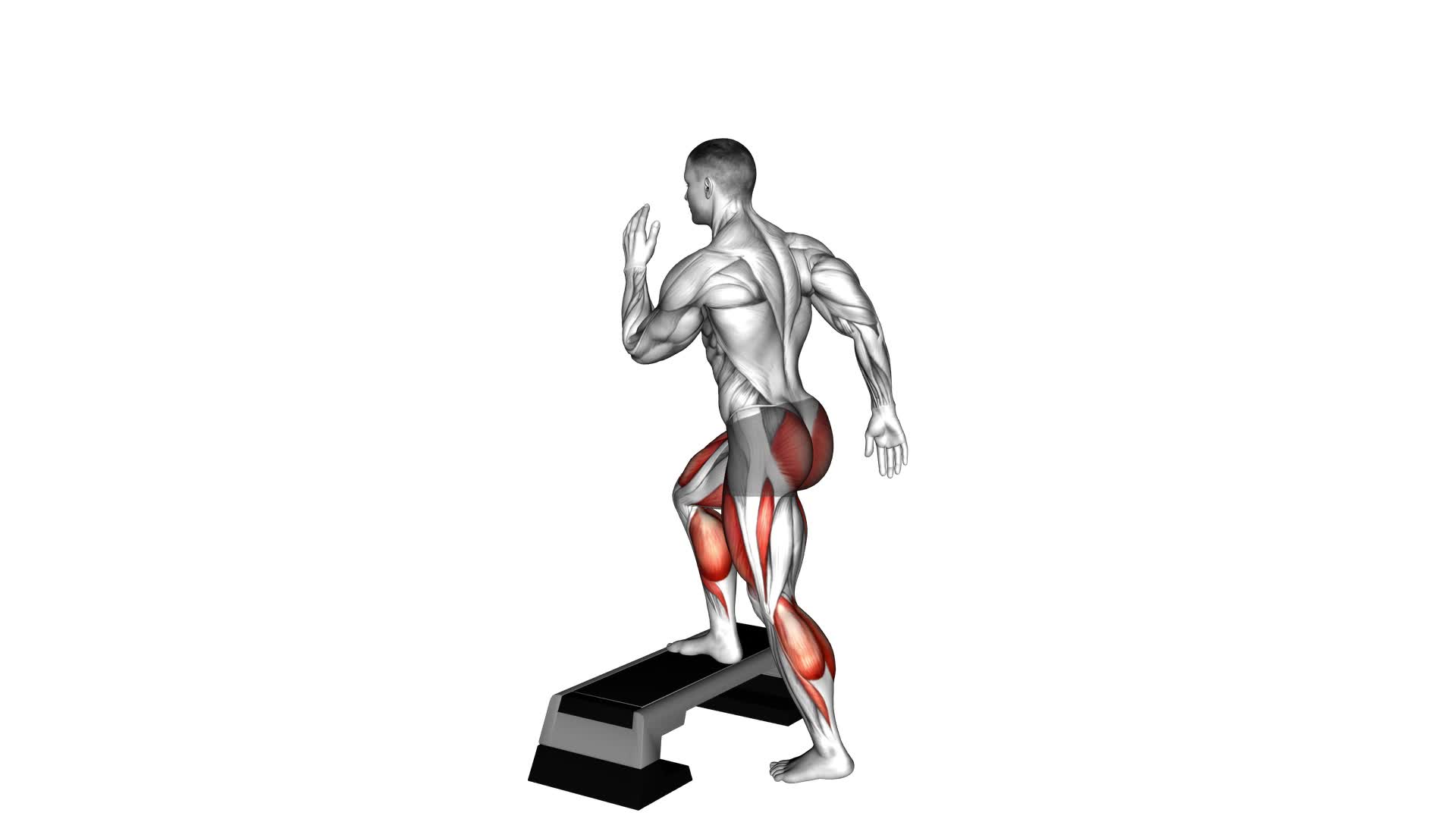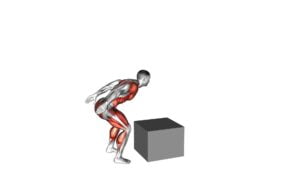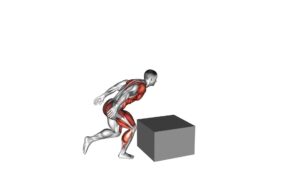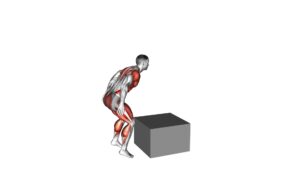Split Jump to Box – Video Exercise Guide & Tips

Are you looking for a challenging lower body exercise that can help you build strength and power? Look no further than the split jump to box.
Watch This Exercise Video
This explosive move targets your legs and glutes, while also improving your balance and agility. In this article, we'll guide you through proper form and technique, offer modifications for different fitness levels, and provide tips to maximize your results and prevent injury.
Get ready to elevate your workout with the split jump to box!
Key Takeaways
- The split jump to box exercise increases lower body strength and explosive power.
- Proper form and technique, including maintaining a strong core and landing softly on the box, are crucial for maximizing the benefits of the exercise and preventing injury.
- Common mistakes to avoid include improper landing technique, failure to maintain proper alignment and stability, and not engaging core muscles for stability.
- Modifications for different fitness levels can be made, such as starting with a lower box height or incorporating a split squat instead of an explosive jump.
Benefits of the Split Jump to Box
You can experience increased lower body strength and explosive power through the benefits of the Split Jump to Box exercise. This exercise involves jumping from a split squat position onto a box, which activates the muscles in your legs and glutes. The explosive movement required for this exercise helps to develop power and strength in your lower body.
By performing the Split Jump to Box exercise, you can target specific muscle groups in your legs, including the quadriceps, hamstrings, and calves. These muscles are essential for activities such as walking, running, and jumping. Additionally, the exercise also engages your glutes, which are important for overall lower body strength and stability.
Not only does the Split Jump to Box exercise help with muscle activation, but it also improves cardiovascular endurance. The fast-paced and high-intensity nature of this exercise gets your heart rate up, which helps to improve your cardiovascular fitness. Incorporating this exercise into your workout routine can benefit not only your lower body strength but also your overall fitness level.
Proper Form and Technique
To ensure proper execution of the Split Jump to Box exercise, maintain a strong and stable core throughout the movement. This exercise not only targets your lower body muscles but also improves flexibility and engages your core.
As you jump and land on the box, focus on keeping your abdominal muscles tight and engaged to provide stability and balance. This will also help activate your glutes, quadriceps, and hamstrings more effectively.
In addition to a strong core, proper form and technique are crucial for maximizing the benefits of this exercise. Make sure to land softly on the box with your knees slightly bent to absorb the impact and prevent any strain or injury. Keep your chest up, shoulders back, and gaze forward to maintain a neutral spine position. This will help activate the correct muscles and prevent any unnecessary stress on your joints.
To further enhance muscle activation, you can incorporate techniques like squeezing your glutes at the top of the jump and focusing on the mind-muscle connection. By consciously contracting and engaging the targeted muscles, you can optimize the benefits of this exercise.
By maintaining a strong core, using proper form and technique, and implementing muscle activation techniques, you can perform the Split Jump to Box exercise effectively and safely.
Now, let's move on to the next section to learn about common mistakes to avoid and how to correct them.
Common Mistakes to Avoid
One common mistake to avoid in the Split Jump to Box exercise is improper landing technique. When performing this exercise, it's crucial to ensure that you land softly and with control. Many people make the mistake of landing too hard or with a heavy impact, which can put unnecessary strain on your joints and increase the risk of injury.
To avoid this mistake, focus on landing with a slight bend in your knees and absorbing the impact through your legs. Another common mistake isn't maintaining proper alignment throughout the exercise. It's important to keep your chest up, shoulders back, and core engaged to maintain stability and prevent any excessive forward or backward leaning.
Additionally, make sure to keep your knees in line with your toes and avoid letting them collapse inward. By paying attention to these technique tips and avoiding these common mistakes, you can perform the Split Jump to Box exercise safely and effectively.
Modifications for Different Fitness Levels
For individuals at various fitness levels, modifications can be made to the Split Jump to Box exercise. Whether you're a beginner or an advanced athlete, there are progression options and adaptations available to suit your needs. Here are some ideas to help you modify the exercise to match your fitness level:
- Start with a lower box height: If you're new to this exercise or have limited lower body strength, begin by using a lower box. This will reduce the distance you need to jump and make the exercise more manageable.
- Use a bench or step instead of a box: If you don't have access to a box or find it too challenging, you can use a sturdy bench or step instead. This will provide a similar workout while offering a lower impact option.
- Incorporate a split squat: If you're not ready for the explosive jump, try performing a split squat instead. This exercise targets the same muscle groups and allows you to work on your stability and control.
- Add weights for an extra challenge: For advanced individuals looking to increase the intensity, holding dumbbells or using a weighted vest can make the exercise more demanding.
By modifying the Split Jump to Box exercise, you can tailor it to your fitness level and gradually progress as you get stronger and more comfortable.
Now, let's move on to the next section where we'll discuss tips for maximizing results and preventing injury.
Tips for Maximizing Results and Preventing Injury
To maximize your results and prevent injury during the Split Jump to Box exercise, it's important to focus on proper form and technique.
First and foremost, make sure you have a sturdy box or platform that can support your weight. This will help prevent any accidents or injuries while performing the exercise.
When starting the jump, remember to engage your core and keep your back straight. This won't only help with stability but also protect your spine from any unnecessary strain.
Additionally, be mindful of your landing. Aim to land softly on the box, using your legs to absorb the impact. This will reduce the risk of joint injuries.
As with any exercise, it's essential to listen to your body. If you feel any pain or discomfort, stop and assess your form. It's better to take a break and correct your technique than to push through and risk injury.
Lastly, don't forget to warm up properly before attempting the Split Jump to Box exercise. This will help prepare your muscles and reduce the likelihood of strains or pulls.
Frequently Asked Questions
How Many Calories Does the Split Jump to Box Exercise Burn?
The split jump to box exercise can help you burn calories effectively. By incorporating variations of this exercise into your routine, you can target different muscle groups and increase the intensity of your workout.
Not only does this exercise burn calories, but it also improves your cardiovascular endurance and strengthens your lower body muscles. Adding the split jump to box exercise into your workout routine can be a great way to challenge yourself and achieve your fitness goals.
Can the Split Jump to Box Exercise Help Improve Vertical Jump Height?
The split jump to box exercise can definitely help improve your vertical jump height. By incorporating this exercise into your routine, you can reap the benefits of overall lower body strength.
To perform the split jump to box exercise effectively, start by standing in a split stance with one foot on the box and the other foot behind you. Jump explosively, switching your foot positions mid-air and landing softly on the box.
Repeat for maximum effectiveness.
Is the Split Jump to Box Exercise Suitable for Individuals With Knee Injuries?
The split jump to box exercise may not be suitable for individuals with knee injuries. It puts a lot of strain on the knees and can worsen the condition.
However, there are modifications you can make to the exercise to make it more knee-friendly, such as reducing the height of the box or using a softer surface.
Alternatively, there are other exercises that can help improve vertical jump height without putting too much pressure on the knees.
How Many Sets and Repetitions Should Be Done for the Split Jump to Box Exercise?
For the split jump to box exercise, the number of sets and repetitions can vary depending on your fitness level and goals. It's important to start with a number that challenges you but is still manageable.
You can begin with 3 sets of 8-10 repetitions and gradually increase as you get stronger. Remember to listen to your body and make any necessary modifications or variations to accommodate your individual needs and abilities.
Can the Split Jump to Box Exercise Be Incorporated Into a Circuit Training Routine?
Yes, you can definitely incorporate the split jump to box exercise into a circuit training routine. It's a great plyometric exercise that can help improve your lower body strength and power.
However, it's important to note that this exercise may not be suitable for individuals with knee injuries. If you have knee issues, you can modify the exercise by performing step-ups or other low-impact exercises instead.
Always listen to your body and consult with a fitness professional if you have any concerns.
Conclusion
In conclusion, the split jump to box exercise is an effective way to improve lower body strength, explosiveness, and balance.
By following proper form and technique, avoiding common mistakes, and making modifications for different fitness levels, you can maximize your results and prevent injury.
Incorporate this exercise into your routine and enjoy the benefits it brings to your overall fitness and athletic performance.
Stay consistent and keep pushing yourself to achieve your goals.

Author
Years ago, the spark of my life’s passion ignited in my mind the moment I stepped into the local gym for the first time. The inaugural bead of perspiration, the initial endeavor, the very first surge of endorphins, and a sense of pride that washed over me post-workout marked the beginning of my deep-seated interest in strength sports, fitness, and sports nutrition. This very curiosity blossomed rapidly into a profound fascination, propelling me to earn a Master’s degree in Physical Education from the Academy of Physical Education in Krakow, followed by a Sports Manager diploma from the Jagiellonian University. My journey of growth led me to gain more specialized qualifications, such as being a certified personal trainer with a focus on sports dietetics, a lifeguard, and an instructor for wellness and corrective gymnastics. Theoretical knowledge paired seamlessly with practical experience, reinforcing my belief that the transformation of individuals under my guidance was also a reflection of my personal growth. This belief holds true even today. Each day, I strive to push the boundaries and explore new realms. These realms gently elevate me to greater heights. The unique combination of passion for my field and the continuous quest for growth fuels my drive to break new ground.







